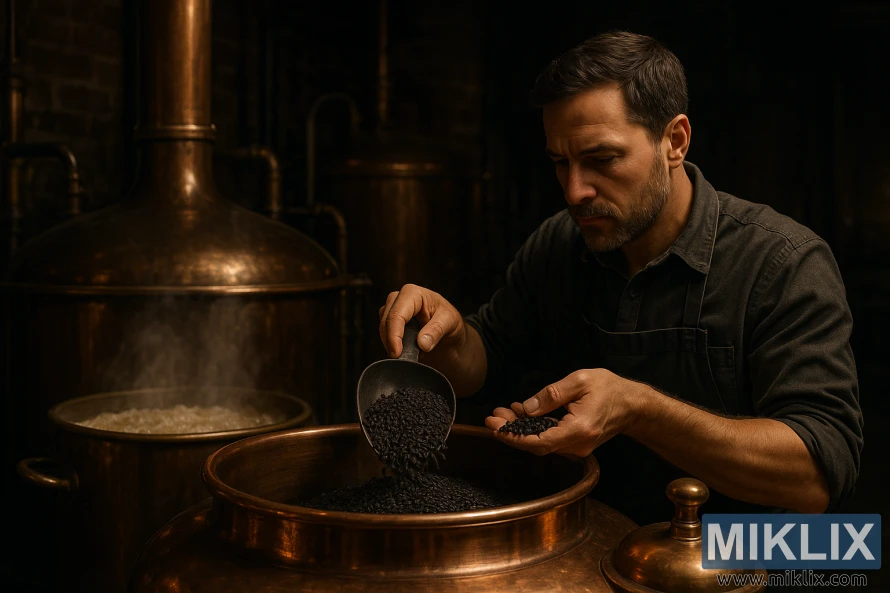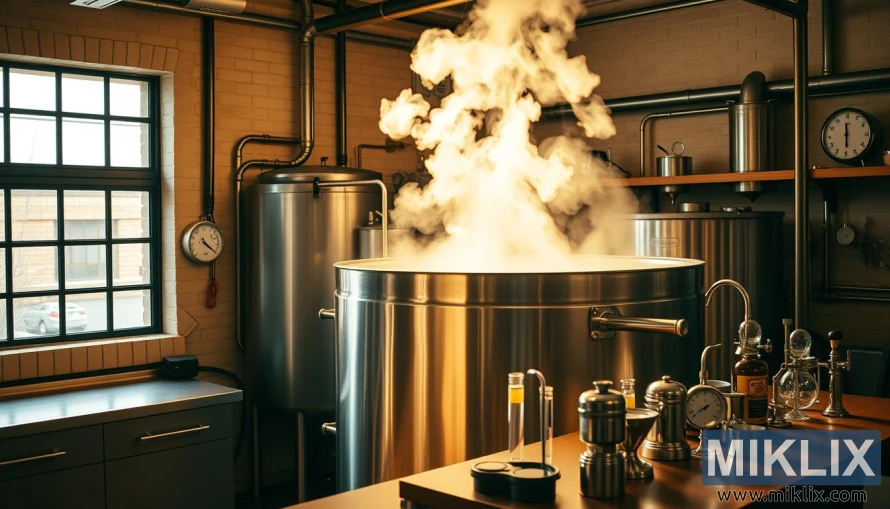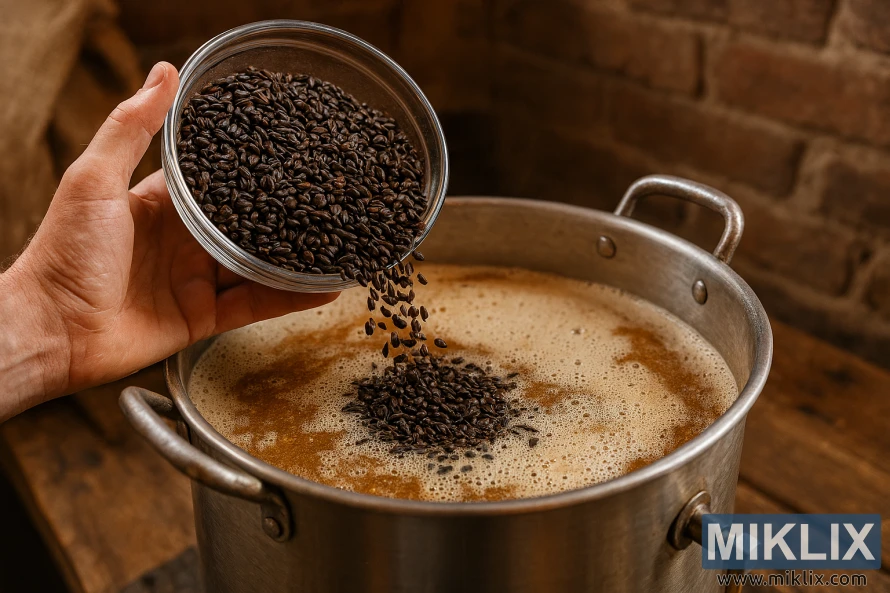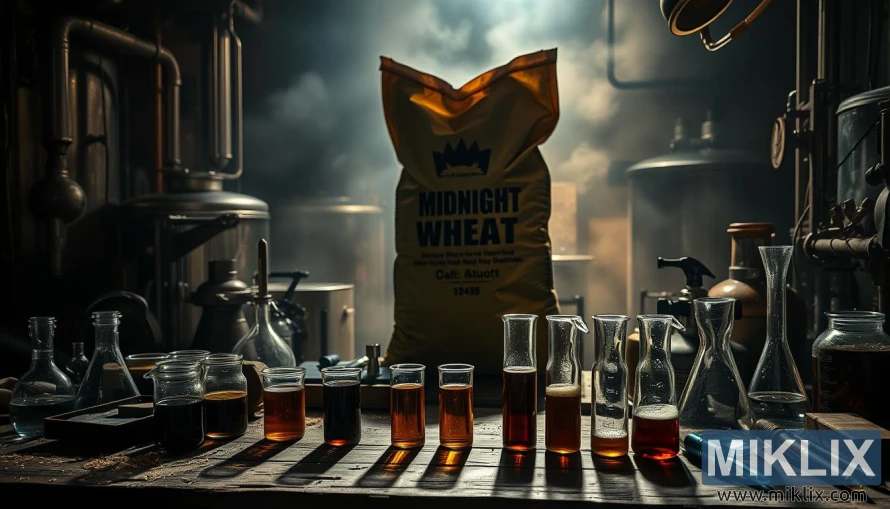Brewing Beer with Midnight Wheat Malt
Published: July 26, 2025 at 7:23:54 AM UTC
Last updated: December 9, 2025 at 6:22:32 PM UTC
Using specialty malts in brewing can significantly enhance your beer's flavor and character. Midnight Wheat Malt stands out for its deep color and smooth roast. It's a game-changer for those aiming to create complex brews. Midnight Wheat Malt brings a roasted, chocolaty taste and a dark hue to beer. It's a must-have for crafting stouts and porters. This malt is crafted to add depth without the harshness, ensuring a smoother finish.

Key Takeaways
- Midnight Wheat Malt adds deep color and smooth roast to beer.
- It provides a roasted, chocolaty flavor ideal for stouts and porters.
- Designed to minimize astringency for a smoother finish.
- Essential for brewers looking to add complexity to their beers.
- Ideal for dark beer recipes.
Understanding Midnight Wheat Malt Characteristics
Midnight Wheat Malt is perfect for brewing beers with a deep color and smooth roast. It boasts a high color rating, usually between 500-600 SRM. This contributes significantly to the beer's dark appearance.
Its flavor profile is both subtle and distinctive. It offers hints of roasted flavors without the harshness often found in darker malts. This makes it a great choice for brewers aiming to craft complex, dark beers with smooth, rounded flavors.
The amount of Midnight Wheat Malt used can vary based on the brewer's objectives. It's commonly employed to enhance the beer's color and add depth to its flavor. Its smooth roast character is highly appealing in styles where a deep color is desired without harsh roast flavors.
Key characteristics include:
- High color rating (500-600 SRM)
- Smooth, subtle flavor profile
- Hints of roasted flavor without astringency
- Versatile usage in various beer styles
The History Behind Midnight Wheat Malt Development
Briess's creation of Midnight Wheat Malt transformed the brewing landscape. It introduced a dark, smooth roasting option, unlike traditional black malts. These malts were known for their bitter, astringent flavors.
The history of Midnight Wheat Malt is deeply connected to the evolution of black malts and the debittering process. Initially, black malts were infamous for their intense, unpleasant tastes. Yet, through malting technology advancements, companies like Briess created malts with the desired color and flavor. They did so without the unwanted attributes.
The debittering process was key in Midnight Wheat Malt's development. It removes unwanted compounds, leading to a smoother taste. The result is a malt that adds deep color and smooth roast to beers. It does so without introducing astringency or dryness.
Midnight Wheat Malt stands out from traditional black malts in both production and taste. Unlike traditional black malts, which can be harsh and bitter, Midnight Wheat Malt offers a refined, smooth character. This makes it perfect for brewers aiming to craft complex, dark beers without the usual drawbacks of darker malts.
- Provides deep color without harsh flavors
- Smooth roast character enhances beer complexity
- Debittering process removes unwanted compounds
The creation of Midnight Wheat Malt marks a major leap in malting technology. It gives brewers a versatile tool for a broad range of beer styles. Its unique traits make it a top choice for brewers looking to innovate and stand out in the market.
Comparing Midnight Wheat Malt to Traditional Dark Malts
Brewing with Midnight Wheat Malt presents a unique alternative to traditional dark malts. It showcases notable differences in flavor and color. The main distinction lies in the grain composition. Midnight Wheat Malt is crafted from grains without husks, leading to a smoother flavor and reduced bitterness or astringency risk.
Traditional dark malts, by contrast, come from grains with husks. This can result in a coarser, more bitter taste in the beer. The absence of husks in Midnight Wheat Malt leads to a cleaner, more refined taste experience.
When comparing the two, brewers should consider the following key differences:
- Flavor Profile: Midnight Wheat Malt offers a smoother, less bitter flavor, while traditional dark malts can introduce a more robust, sometimes astringent taste.
- Color Contribution: Both types of malts can contribute to the beer's color, but Midnight Wheat Malt tends to produce a deeper, richer hue without the harshness associated with some traditional dark malts.
- Usage in Recipes: Midnight Wheat Malt can be used to create complex, dark beers without the astringency often associated with dark malts, making it an attractive option for brewers seeking to innovate their recipes.
By understanding these differences, brewers can make informed decisions about when to use Midnight Wheat Malt versus traditional dark malts. This allows for greater creativity and control over the brewing process.
Benefits of Using Midnight Wheat Malt in Beer Recipes
Midnight Wheat Malt is a game-changer for brewers aiming for a deep, rich color and smooth roast in their beers. This specialty malt offers a unique blend of characteristics. These enhance the overall quality of the beer.
One key benefit of Midnight Wheat Malt is its ability to add a deep, rich color to the beer. This is highly desirable for brewers aiming to create dark, complex beers like stouts, porters, and dark ales. The malt's deep color contribution helps brewers achieve the desired appearance without sacrificing flavor.
Midnight Wheat Malt is also prized for its smooth roast flavor. Unlike some other dark malts, it provides a subtle, roasted flavor without astringency or bitterness. This makes it perfect for brewers looking to add depth to their beers without harsh flavors.
The benefits of Midnight Wheat Malt can be summarized as follows:
- Deep, rich color contribution
- Smooth, subtle roast flavor
- No astringency or bitterness
By incorporating Midnight Wheat Malt into their recipes, brewers can craft complex, flavorful beers that stand out. Whether brewing a traditional style or experimenting with a new recipe, Midnight Wheat Malt is a valuable ingredient to consider.
Optimal Usage Rates and Proportions
To maximize the benefits of Midnight Wheat Malt, brewers must grasp its optimal usage rates. Briess suggests adding Midnight Wheat Malt at a 1-2% rate for minor color tweaks. This approach subtly enhances the beer's color without dominating its other flavors.
For those aiming for a deeper color and richer taste, using up to 10% Midnight Wheat Malt is recommended. This higher amount not only deepens the color but also enriches the flavor profile.
When deciding on the right amount, brewers should think about the beer's desired characteristics. Adjusting the proportions allows for the perfect balance of color and flavor intensity.
- For subtle color adjustments: 1-2% Midnight Wheat Malt
- For pronounced color and flavor: up to 10% Midnight Wheat Malt
By fine-tuning the Midnight Wheat Malt proportion, brewers can craft a balanced and refined beer. This ensures their brewing goals are met.
Temperature Control During Mashing
Achieving optimal extraction of flavors and colors from Midnight Wheat Malt requires precise temperature control during mashing. This control is critical, as it directly impacts the brew's quality.
The mashing process involves soaking malted grains in hot water. This extraction process targets sugars, flavors, and colors. The temperature at which this occurs significantly affects enzymatic activity. It influences the type and quantity of extract obtained.
To achieve optimal extraction, brewers should consider the following temperature control strategies:
- Maintain a consistent temperature between 152°F and 158°F (66°C to 70°C) for optimal enzymatic activity.
- Monitor the temperature closely to avoid overheating, which can lead to the extraction of undesirable compounds.
- Adjust the mashing temperature based on the specific characteristics of Midnight Wheat Malt and the desired beer profile.
By implementing these strategies, brewers can ensure optimal extraction of flavors and colors from Midnight Wheat Malt. This results in a high-quality brew with the desired characteristics.

Impact on Beer Styles and Color Development
Midnight Wheat Malt is perfect for crafting Black IPAs, stouts, and porters. It influences both their color and flavor. Its distinct traits make it a top pick for brewers aiming to brew complex, dark beers.
Midnight Wheat Malt greatly affects beer color. It brings out a deep, rich hue typical of dark beers. Its smooth roast adds to the beer's appearance, giving it a luxurious feel.
Brewers can adjust the amount of Midnight Wheat Malt to fine-tune color and taste. It pairs well with other specialty malts, allowing for a unique beer profile.
- Black IPAs: Midnight Wheat Malt adds depth and complexity to these hoppy beers.
- Stouts: The malt's smooth roast character enhances the overall flavor and texture.
- Porters: Midnight Wheat Malt contributes to a rich, complex flavor profile.
By using Midnight Wheat Malt, brewers can craft a variety of beers. These showcase the malt's unique qualities.
Managing Mouthfeel and Body
Brewing with Midnight Wheat Malt offers brewers a unique chance to enhance the mouthfeel and body of their beers. This specialty malt is renowned for its contribution to a smooth, creamy mouthfeel and a rich, full body. It's a key ingredient for brewers aiming to create high-quality beers.
The mouthfeel of a beer is a critical aspect, influencing its feel in the mouth and drinkability. Midnight Wheat Malt adds depth and complexity, playing a significant role in improving this aspect. It helps achieve a balanced mouthfeel that complements the beer's flavor.
Managing a beer's body is equally important, affecting its overall weight and texture. Midnight Wheat Malt can make the beer more satisfying and enjoyable by adding to its body. Brewers can adjust the amount of Midnight Wheat Malt in their recipe to achieve the desired body, considering the beer style and desired characteristics.
Here are some key considerations for using Midnight Wheat Malt to manage mouthfeel and body:
- Start with a small proportion of Midnight Wheat Malt and adjust to taste, as it can significantly impact the beer's character.
- Consider the style of beer you are brewing and how Midnight Wheat Malt will contribute to its overall profile.
- Experiment with different proportions to find the optimal balance for your specific brew.
By carefully managing the use of Midnight Wheat Malt, brewers can create beers with a superior mouthfeel and body. This enhances the overall drinking experience.
Achieving Smooth Roast Character
Many brewers aim for a smooth roast character in their beers. Midnight Wheat Malt can be a key ingredient in achieving this goal. It adds depth without the harshness often found in darker malts. Used correctly, it balances the roast flavor with other ingredients.
To achieve a smooth roast, brewers must consider a few factors. The ratio of Midnight Wheat Malt to other malts is critical. Too much can overwhelm the beer, while too little may not impact it enough. Start with a small amount and adjust to taste.
The brewing process also plays a significant role. Temperature control during mashing is essential for flavor extraction. Keeping the mash temperature in the optimal range ensures a smooth extraction of roast flavors.
- Start with a small percentage of Midnight Wheat Malt and adjust to achieve the desired roast character.
- Monitor mash temperature to ensure optimal enzyme activity.
- Balance the roast flavor with other ingredients to avoid overpowering the beer.
By managing Midnight Wheat Malt use and the brewing process, brewers can enhance their beer's flavor. This not only improves the drinking experience but also makes the beer stand out in a competitive market.

Preventing Astringency in Your Brew
The secret to a great brew with Midnight Wheat Malt lies in minimizing astringency. Astringency can ruin an excellent beer, causing an unpleasant dryness or bitterness. Midnight Wheat Malt is designed to provide a smooth, subtle flavor with no astringency or bitterness. It's a favorite among brewers for this reason.
To prevent astringency, brewers should first ensure proper mashing techniques. This includes maintaining the right temperature and pH levels.
Here are some key strategies to minimize astringency when brewing with Midnight Wheat Malt:
- Monitor your mash temperature closely to avoid extracting unwanted compounds.
- Use water with the appropriate profile for your beer style to prevent over-extracting tannins.
- Be mindful of the grain-to-water ratio to avoid astringent flavors.
By following these brewing tips and understanding the characteristics of Midnight Wheat Malt, brewers can achieve a smooth, balanced flavor in their beers. Proper handling and storage of the malt are also key in preventing astringency.
In conclusion, preventing astringency is critical for brewers using Midnight Wheat Malt. With the right techniques and attention to detail, brewers can unlock the full flavor of this specialty malt.
Storage and Handling Requirements
Preserving the unique qualities of Midnight Wheat Malt requires proper storage and handling. Ensuring the malt's flavor and color remain intact is key. This involves adhering to specific conditions.
Midnight Wheat Malt should be stored in a cool, dry environment. It's vital to keep it away from sunlight, moisture, and heat. The ideal storage area maintains a temperature between 50°F to 70°F (10°C to 21°C) and low humidity.
- Store in airtight containers to prevent moisture absorption.
- Keep the storage area clean and free from pests.
- Avoid storing near strong-smelling products, as Midnight Wheat Malt can absorb odors.
When handling Midnight Wheat Malt, be gentle. Dropping or crushing it can damage its quality. By following these guidelines, you can keep your Midnight Wheat Malt in the best condition for brewing.
Common Brewing Mistakes to Avoid
To fully appreciate Midnight Wheat Malt, brewers must steer clear of common errors. A few essential considerations can greatly enhance the quality and taste of the final brew.
Proper mashing techniques are critical when using Midnight Wheat Malt. Incorrect mashing temperatures or poor grain crushing can hinder efficient extraction. This affects the beer's character. Achieving the right mash temperature and ensuring grains are crushed correctly can prevent these problems.
Another frequent mistake is neglecting to adjust brewing methods for Midnight Wheat Malt's unique traits. This malt adds a deep color and smooth roast flavor but needs careful handling to avoid astringency or unbalanced tastes. Brewers must be attentive to the malt's characteristics and adjust their techniques appropriately.
Here are some key tips to avoid common brewing mistakes when using Midnight Wheat Malt:
- Monitor mashing temperatures closely to ensure optimal extraction.
- Adjust the brewing process according to the malt's characteristics.
- Be cautious of over-sparging, which can lead to astringency.
- Store Midnight Wheat Malt properly to maintain its freshness and quality.
By recognizing these common pitfalls and taking steps to sidestep them, brewers can fully exploit Midnight Wheat Malt's capabilities. This results in high-quality beers with unique and complex flavor profiles.

Pairing Midnight Wheat Malt with Other Specialty Malts
Brewers can pair Midnight Wheat Malt with other specialty malts to create a rich, nuanced flavor. This blend allows for the development of complex and unique beer flavors. It enhances the overall character of the brew.
Midnight Wheat Malt is versatile, pairing well with various specialty malts. For example, combining it with chocolate malt introduces a deep, cocoa-like flavor. Mixing it with caramel malt adds a sweet, malty note.
Some popular specialty malts to pair with Midnight Wheat Malt include:
- Aromatic malts, which add a spicy and malty flavor
- Victory malts, which contribute a toasted and biscuity character
- Melanoidin malts, which enhance the beer's maltiness and complexity
When pairing Midnight Wheat Malt with other specialty malts, brewers should aim for a balanced flavor profile. By balancing the characteristics of each malt, brewers can achieve a harmonious and complex flavor experience.
The success of pairing depends on understanding how malts interact. By experimenting with different combinations, brewers can craft unique and delicious beer styles. These showcase the versatility of Midnight Wheat Malt.
Commercial Beer Examples Using Midnight Wheat Malt
## Commercial Beer Examples Using Midnight Wheat Malt
Several breweries have successfully incorporated Midnight Wheat Malt into their commercial beers. This malt has been used in various beer styles, resulting in complex flavor profiles and distinctive brewing outcomes.
Breweries have experimented with Midnight Wheat Malt, producing a range of commercial beers. For instance, some breweries have used it to create dark, rich porters and stouts with smooth roast characters. Others have incorporated it into wheat beers, boosting their complexity and depth.
Some notable examples of commercial beers brewed with Midnight Wheat Malt include:
- Porters with deep, rich flavors and smooth roast characters
- Stouts with complex, dark fruit flavors and velvety textures
- Wheat beers with enhanced complexity and subtle malt notes
These beers demonstrate the versatility of Midnight Wheat Malt and its ability to enhance various beer styles. The use of this malt has resulted in a range of distinctive commercial beers that showcase its unique characteristics.
The success of these commercial beers highlights the brewing possibilities of Midnight Wheat Malt. By incorporating this malt into their recipes, breweries can create complex, distinctive beers that stand out in the market.
Professional Brewer Insights and Tips
Experienced brewers offer valuable tips on using Midnight Wheat Malt to its fullest. They share their knowledge on the subtleties of working with this specialty malt. This includes optimizing mash temperatures and boosting the beer's character.
Temperature control during mashing is a critical point made by professional brewers. The right temperature ensures the enzymes in Midnight Wheat Malt are fully active. This leads to a smoother, more complex flavor.
They also suggest experimenting with different ratios of Midnight Wheat Malt in your recipes. Its versatility means its impact can change based on other malts used. For example, mixing it with lighter malts can balance flavors, while dark malts can create a robust beer.
Another key point is to watch the beer's color when using Midnight Wheat Malt. Its deep color can greatly affect the beer's look. Adjusting the amount used can help achieve the desired visual effect.
When it comes to mouthfeel and body, brewers advise considering the malt's gravity contribution. Adjusting the recipe to match the malt's characteristics can lead to a balanced mouthfeel.
- Optimize mash temperatures for enzyme activation.
- Experiment with different proportions of Midnight Wheat Malt.
- Monitor color development for the desired appearance.
- Adjust recipes to manage mouthfeel and body.

Conclusion
Mastering Midnight Wheat Malt can transform your brewing, allowing you to create unique, delicious beers. These beers will have deep color and a smooth roast. By grasping its characteristics and optimal usage, you open new doors in your brewing adventures.
This article has covered Midnight Wheat Malt's history, benefits, and best practices. You now know how to control temperature during mashing and pair it with other malts. This knowledge empowers you to fully utilize its capabilities.
As you move forward in brewing, we urge you to explore Midnight Wheat Malt's full range. It offers endless possibilities for flavor and creativity. Your next masterpiece is just a brew away with Midnight Wheat Malt.
Further Reading
If you enjoyed this post, you may also like these suggestions:
